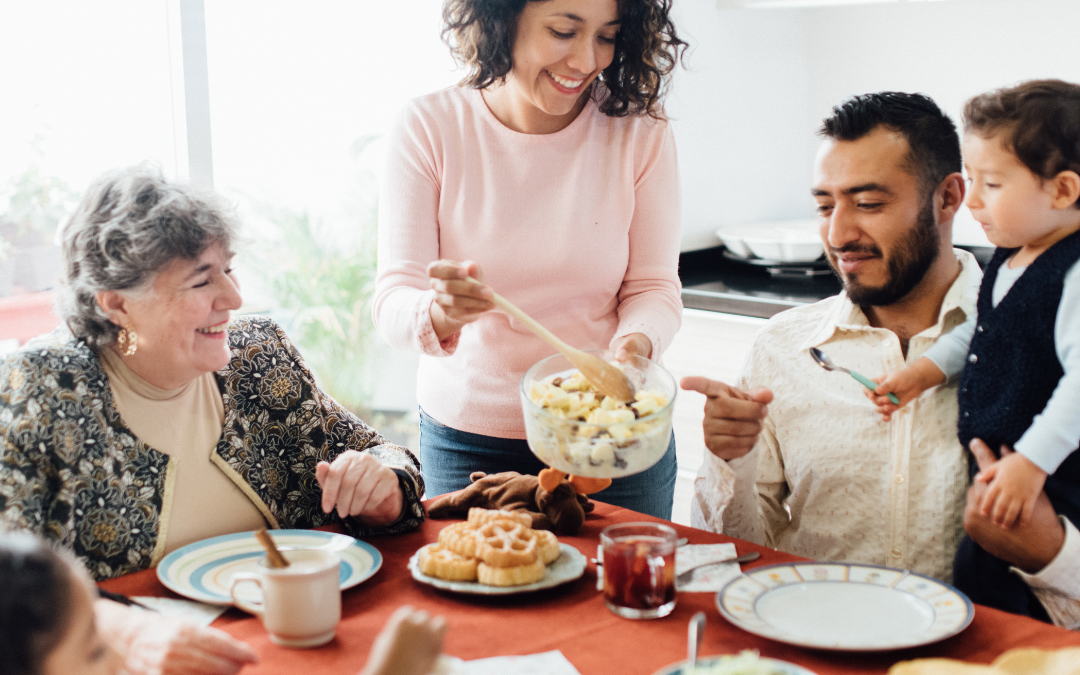
by Guest | May 23, 2025 | Being Well, Featured, Uncategorized, Work Well
By Cami Aufdermauer
May is Mental Health Awareness Month, and it’s a powerful reminder to check in not only on the people around us but on ourselves. Mental health isn’t just about crisis moments or diagnoses. It’s about wellness, a daily practice of showing up for your mind, your emotions, and your purpose.
For me, one of the most important things I’ve learned is this: mental health is rooted in connection. The more connected we are to ourselves, to others, and to something greater, the stronger and more resilient we become.
Connection to self means knowing yourself well enough to recognize what you need. Sometimes it’s reaching out for support. Sometimes it’s taking a walk, unplugging for a bit, or simply giving yourself permission to rest. Living with a growth mindset means asking, “What is this moment trying to teach me?” instead of, “What’s wrong with me?” It’s about being kind and curious with your inner world.
Connection to others is equally vital. We’re not meant to do life alone. Who’s in your circle? Who lifts you up, checks in on you, challenges you to grow? For me, I’ve found deep support in my church community and in my roles as a child advocate and hospice chaplain. These spaces remind me that I’m not the only one carrying hard things, and that compassion and shared experience can be healing.
And finally, connection to purpose is what keeps me going. I believe there’s a greater plan at work in my life. Knowing I’m part of something bigger helps me step outside of my own anxiety or stress and re-center on what really matters. Purpose gives me the courage to show up, even on the hard days, because I know my presence and my voice matter.
If you’re feeling disconnected or overwhelmed, you’re not alone. But I encourage you to pause and ask: How connected am I to myself, to my people, to my purpose?
Mental health isn’t just an individual journey. It’s a shared one. The more we choose connection, the stronger and more whole we become.
You don’t have to have it all together. You just have to stay connected.

by Guest | May 7, 2025 | Being Well, Featured, Uncategorized
Written by: Denise Donohue
Ever get that awful pit in your stomach? Or feel your heart start to race, sweat bead up on your forehead, or a wave of nausea hit out of nowhere? Yep—welcome to anxiety.
But here’s the thing: these feelings are actually “normal”. Anxiety is our brain’s built-in alarm system. It’s designed to protect us from danger, whether it’s real or perceived. Back in caveman days, this alarm system kept our ancestors alive. Imagine they’re out hunting when a sabertooth tiger appears. If their brain didn’t sound the alarm—triggering anxiety to prepare them to run or fight—they might have ended up as lunch.
The tricky part is… our modern brain doesn’t know the difference between a life-threatening tiger and a traffic jam, a stressful email, or a heated conversation with someone we love. To your brain, it all feels like danger.
When anxiety hits, your brain kicks into what we call “fight, flight, or freeze” mode—or as I like to say, ” The F3 Mode”. And not only do you feel physical symptoms, but you may also notice changes in your behavior. You might:
– Isolate yourself
– Shut down emotionally (freeze)
– Lash out or become irritable
– Reach for something comforting—like food, alcohol, or a distraction
The good news? You’re not broken. You’re human. And anxiety, while uncomfortable, is something we can understand and learn to manage with the right tools.
So What Can You Do When Anxiety Hits?
When that overwhelming feeling creeps in—your heart racing, your palms sweating, your brain shouting “DANGER!” even though you’re just checking your email—it’s time to gently take the wheel back from your inner sabertooth tiger alarm system.
Here are some practical steps you can take the moment anxiety starts to take over:
1. Pause and Name It
Start by saying to yourself, “Okay, I’m feeling anxious right now.” Just naming it can help. You’re not weird, broken, or weak—you’re experiencing a totally normal response. Anxiety doesn’t like to be ignored, but it also doesn’t love being calmly called out either. It takes away some of its power.
2. Breathe Like a Pro
Seriously—two slow, deep belly breaths. Not the kind of shallow chest breaths you do when you’re pretending everything’s fine. We’re talking big, slow inhales that make your belly rise, followed by long, slow exhales that say to your brain, “We are not in actual danger right now.”
3. Catch the Thought – and Flip It
Ask yourself: “What thought just zipped through my head?”
Was it something like, “I’m totally going to mess this up”?
Flip the script:
Try, “I’m doing my best, and I can do hard things”
That tiny shift can change how you feel and what you do next.
4. Do the Opposite Action
If your anxiety wants you to hide in bed all day…put on real pants (yes, actual pants) and step outside—even if it’s just for five minutes. If your brain is telling you to avoid that awkward conversation? Write down what you would say, even if you’re not ready to say it yet. Doing the opposite of what anxiety demands gently reminds your brain that you’re the boss.
5. Be Kind to Yourself (Really, You Deserve It)
Your anxious brain is working overtime trying to protect you. So instead of judging yourself, try saying, “This is hard, but I’m handling it.” That little boost of self-compassion is one of the most powerful tools you have.
Final Thoughts: You Are Not Your Anxiety!!!
Anxiety might be loud, messy, and dramatic (kind of like that one friend who always thinks everything is a catastrophe). But it doesn’t get to run the show. You’ve got tools. You’ve got awareness. And now—you’ve got a plan.
The more you practice, the easier it becomes to pause, breathe, reframe your thoughts, and take small steps toward calm. You won’t always get it perfect, but the goal isn’t perfection—it’s progress.
Need a little extra support?
If anxiety is something you’re ready to tackle with more guidance, you’re not alone—and you don’t have to figure it out on your own. Denise Donohue is a life coach who specializes in working with teens and women. Learn more about Denise at www.optimallifecoachingforteens.com

by Guest | Apr 23, 2025 | Being Well, Featured, Uncategorized
In our fast-paced world, it’s easy to feel overwhelmed and disconnected. The constant influx of information and demands on our time can leave us feeling stressed and reactive. Cultivating mindfulness, the practice of paying attention to the present moment without judgment, can be a powerful antidote. Thankfully, numerous free apps are now available to guide us on this journey towards greater awareness and inner peace.
Several excellent free apps offer a fantastic starting point for anyone curious about mindfulness. Insight Timer boasts a vast library of guided meditations, talks, and music tracks led by teachers from around the globe. Its community aspect and diverse content make it a rich resource for both beginners and experienced practitioners.
Smiling Mind, offers a range of free programs designed for various age groups, including adults, children, and educators. Their meditations focus on stress reduction, sleep improvement, and overall mental well-being. Finally, Aura provides personalized mindfulness exercises, sleep stories, and music based on your mood. Its free version offers a daily three-minute meditation and access to a basic library of content.
While these apps offer valuable tools and guidance, the foundation of mindfulness often comes down to something incredibly simple: breathing. In the midst of a busy day, taking even a few moments to consciously focus on your breath can make a significant difference.
Think of it as a mini-reset button for your nervous system. When we feel stressed, our breathing often becomes shallow and rapid. Consciously slowing down our breath signals to our body that it’s safe to relax. Even a minute or two of deep, intentional breathing can help to calm racing thoughts, reduce muscle tension, and bring us back to the present moment.
You don’t need an app to practice mindful breathing. You can do it anywhere, anytime. Simply find a comfortable position, close your eyes if you wish, and bring your attention to the sensation of your breath as it enters and leaves your body. Integrating short breathing breaks throughout your day can be surprisingly impactful. Try taking a few deep breaths before starting a challenging task, during a moment of frustration, or simply as a pause between activities. These small moments of conscious breathing can accumulate, fostering a greater sense of calm and presence throughout your day.
The journey to mindfulness doesn’t require hours of meditation. By leveraging the accessibility of free mindfulness apps and prioritizing even a few moments of conscious breathing, we can cultivate greater awareness, reduce stress, and navigate our lives with more ease and intention. So, take a deep breath, explore these resources, and discover the power of finding calm in your everyday life.

by Guest | Feb 12, 2025 | Being Well, Eat Well, Featured, Uncategorized
Valentine’s Day is often associated with grand romantic gestures, chocolates, and flowers, but at its core, it’s a celebration of love. Additionally, for those who may not have a partner, it can sometimes feel like a day of loneliness, often referred to as Single Awareness Day. Let’s start looking at Valentine’s Day differently. While we may frequently focus on showing love to others, it’s just as important to show love to ourselves. Self-care is the ultimate act of self-love, and what better time to prioritize it than during a season dedicated to the heart?
Why Self-Care Matters
Self-care isn’t just about indulging in spa days or treating yourself to your favorite dessert—though those can be wonderful! It’s about intentionally caring for your mental, emotional, physical, and, if possible, financial well-being. In our busy lives, we often put others first, whether our families, jobs, or community commitments. We usually push our own needs aside. However, there’s a reason why flight attendants instruct us to put on our own oxygen masks first before assisting others. Ensuring our own well-being first enables us to better support those around us. Taking time to nurture ourselves allows us to show up more fully for the people and responsibilities that matter most. Seeking guidance is also a form of self-care. This could be reaching out to a friend, a family member, or a counselor.
Simple Ways to Practice Self-Care
If you’re unsure where to start, here are a few simple yet meaningful ways to prioritize self-care this Valentine’s Day:
1. Nourish Your Body
Remember to eat like you love yourself! Fuel yourself with foods that make you feel good—both physically and emotionally. Cook a nutritious meal, enjoy a cup of tea, or savor that piece of chocolate guilt-free. You can find healthy recipes on
www.FoodHero.org. Meal planning, shopping smart, and preparing healthy meals can also be a from of self-care as it takes the stress away of meal time. Try meal prepping at the beginning of the week to save time and make healthier choices easier.
2. Move in a Way That Feels Good
Exercise doesn’t have to be a chore. Whether it’s a walk outside, a yoga session, or dancing in your living room, find movement that brings you joy. This could even be something small, like taking the stairs instead of the elevator or parking farther away from the door when going somewhere. Did you know that getting at least 150 minutes of physical activity each week can significantly lower your risk of developing chronic diseases? Small daily changes can add up to make the biggest impact. It’s also a natural antidepressant that can help brighten these cold, dark winter days.
3. Prioritize Rest
Give yourself permission to slow down. Take a nap, go to bed earlier, or spend some time reading a book without distractions. It’s okay to skip an event if you need time for yourself. Establish a nighttime routine to help you wind down. This could mean putting electronics away at a certain time or taking a few minutes before bed to stretch. Listen to your body and rest when you need it.
4. Engage in Activities That Bring Joy
What makes you feel truly heart happy? Maybe it’s painting, gardening, playing music, playing with your fur babies, or simply taking a mid-day nap. Carve out time for the things that make you happy. Start small by dedicating 10 minutes a day to something you love. Treat it like an important meeting with your boss—one you wouldn’t cancel.
5. Set Boundaries
Saying ‘no’ can be an act of self-care. Protect your time and energy by setting boundaries that allow you to prioritize what truly matters. Boundaries help create balance in your life and prevent burnout. They allow you to manage your emotional well-being by limiting interactions that drain you and focusing on those that uplift you. Setting boundaries might look like turning off your phone during personal time, declining commitments that overwhelm you, or clearly communicating your needs to others. Remember, setting boundaries is not about shutting people out; it’s about making space for what brings you peace and fulfillment.
6. Practice Self-Compassion
Be kind to yourself. Speak to yourself as you would a dear friend, and let go of perfectionism. You are worthy of love and care exactly as you are. Self-compassion also means acknowledging your progress, no matter how small, and celebrating the effort you put into improving yourself. Give yourself grace on difficult days and remember that setbacks are a part of growth. Practicing self-compassion can also involve journaling positive affirmations, engaging in self-care activities that make you feel valued, and surrounding yourself with people who uplift and encourage you.
A Valentine’s Day Promise to Yourself
This Valentine’s Day, promise to love yourself a little more and be kinder to yourself. Whether that means treating yourself with kindness, taking a break, or simply acknowledging your own worth, Understand that taking time for yourself might feel unusual, and change can be scary and uncomfortable, but prioritizing self-care is essential and takes time. Self-care is not all or nothing; it’s about taking it one day at a time. Recognize that you are just as deserving of the love and support you give to others. Self-care isn’t selfish—it’s necessary. You are important and you matter to so many people.
So, while you’re celebrating love in all its forms, don’t forget to celebrate yourself too. You deserve it.
Written by: Galena Flores, SNAP- Education Program Assistant, and Tillamook County Wellness Contributor

by Michelle | Jan 31, 2025 | Being Well, Eat Well, Featured, Uncategorized
Did you know simple mealtime routines can set children up for success? Providing nutritious foods that nourish a child’s physical and mental development is important; however, predictable mealtime patterns can be equally, if not more, important. Safe, consistent and nurturing care are critical for the development of a young child’s nervous system. These factors contribute to a child’s ability to make sense of the world and the degree to which they feel a sense of agency or control over their place in the world. Early childhood experiences shape how their bodies and minds will react to adversity in the future. Parents and caregivers can use mealtimes to reinforce safety and shared expectations with children as a way to build resilience.
The book, Hungry for Love, by Registered Dietician Charlie Slaughter describes how establishing set mealtimes with consistent, shared expectations between caregiver and child strengthens bonds of trust and feelings of safety. Even if parents have not had this modeled for them in their own lives, they can adopt these simple practices within their own family environment. The earlier children are exposed to established routines, the better. If children are older, it can be more challenging to shift family norms. As with any effort to change habits, it’s best to make small changes over time and to be patient with progress.
Following are some research-backed strategies to consider:
Eat Together: Establish and maintain consistent mealtimes in a designated location. Ideally this is the dining or meal preparation area, to be associated with eating together as a family as often as possible. Even if it is only a few nights a week, setting this pattern creates expectations that spending time being nourished together is a priority. Let’s face it. We need to eat to survive. And we need each other to survive. There aren’t many better ways to instill a sense of safety and security in children than to prioritize eating meals together in a calm and supportive setting. Our family rule was that food could only be eaten in the “hard floors” part of the house. Since we had carpet in the living room, this meant meals and snacks had to be consumed in the kitchen or dining area. Yes, it kept my house a lot cleaner but the main idea was to focus on food and family. This also helped limit snacking so the kids were hungry for mealtimes.
Foster Connection: Families are busy. It’s okay to have boxed macaroni and cheese with fish sticks or even take and bake pizza for dinner sometimes. What’s important is to establish spending time together as the priority. Eating around the television or using cell phones during meals signals the importance of sources other than the child and they will get that message loud and clear. Instead, use meal times as a safe, welcoming environment to discuss everyday events, feelings and challenges. Our family used “high,low, middle” as a mealtime conversation starter. “Tell us your high and your low from today and something interesting that happened.” Asking kids open-ended questions helps parents learn more about their child’s perspective and it helps the child develop crucial skills of self-awareness and empathy.
Set Clear but Compassionate Expectations – and stick to them: Introduce choices to build a sense of agency or control while also setting clear expectations. “Would you like green beans or broccoli?” The message here is that we are going to eat healthy vegetables but you can choose which one. Families can fall into patterns where mealtimes become a power play. “You WILL eat your vegetables!” This is a great way to train a child to avoid vegetables for the rest of their life. It can take multiple introductions of certain foods before kids form a positive association. Find ways to empower children to try new things. We had a rule that each child had to eat at least as many bites of their vegetables as they were old. If you were three, you ate three green beans. It was a crazy idea that actually worked really well for us in getting our kids to try new foods.
Many people grow up as members of the “clean plate” club; where the expectation is that every morsel of food on the plate has to be consumed. This can set children up for disordered eating patterns later on. Consider using divided plates to help children learn portion control and let them dish up servings for themselves when they are old enough. This helps develop mindful eating patterns where portion sizes are driven by hunger and satiety cues rather than mere habit. Welcoming, safe mealtimes also support kids eating more slowly which will help them recognize those cues.
Last but not least, set consistent expectations around dessert. Rather than establishing a pattern that every meal ends in dessert, consider having fruit or no dessert after dinner most nights of the week and designate one or two nights a week for special treats. According to the American Heart Association, it is estimated that Americans consume 2 to 3 times the recommended daily allowance of sugar. That adds up to about 60 pounds – the equivalent of six, 10-pound bowling balls – every year. Setting family norms around sugar consumption is critical for lifelong health. Our family eliminated candy early on as a way to reduce artificial ingredients in our kids’ diets. We allowed chocolates as small treats and designated Friday as “ice cream night.” To make it even more special, it was the one exception to eating in the living room.
Mealtimes are more than just opportunities to nourish our bodies—they are powerful moments to nurture our children’s emotional and psychological well-being. By establishing predictable routines, fostering connection, and setting compassionate yet clear expectations, we can create a safe and supportive environment that helps children feel secure, understood, and empowered. These simple yet impactful strategies not only contribute to healthier eating habits but also build resilience, emotional regulation, and a sense of belonging.
AUTHOR: Michelle Jenck, Adventist Health Tillamook Director of Community Well-Being





